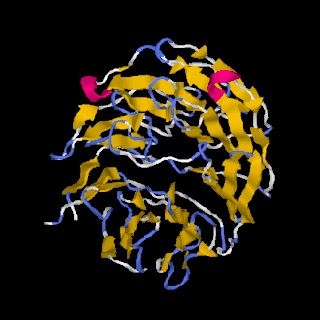Related Research Articles

The apoptosome is a large quaternary protein structure formed in the process of apoptosis. Its formation is triggered by the release of cytochrome c from the mitochondria in response to an internal (intrinsic) or external (extrinsic) cell death stimulus. Stimuli can vary from DNA damage and viral infection to developmental cues such as those leading to the degradation of a tadpole's tail.

WD repeat-containing protein 8 is a protein that in humans is encoded by the WDR8 gene.

WD repeat-containing protein 5 is a protein that in humans is encoded by the WDR5 gene.

Autophagy related 16 like 1 is a protein that in humans is encoded by the ATG16L1 gene. This protein is characterized as a subunit of the autophagy-related ATG12-ATG5/ATG16 complex and is essentially important for the LC3 (ATG8) lipidation and autophagosome formation. This complex localizes to the membrane and is released just before or after autophagosome completion.

WD repeat domain phosphoinositide-interacting protein 2 is a protein that in humans is encoded by the WIPI2 gene.

WD repeat-containing protein 1 is a protein that in humans is encoded by the WDR1 gene.

F-box/WD repeat-containing protein 5 is a protein that in humans is encoded by the FBXW5 gene.
Coronin is an actin binding protein which also interacts with microtubules and in some cell types is associated with phagocytosis. Coronin proteins are expressed in a large number of eukaryotic organisms from yeast to humans.

WD repeat domain phosphoinositide-interacting protein 4 (WIPI-4) is a protein that in humans is encoded by the WDR45 gene. Mutations in this gene cause a distinct form of Neurodegeneration with brain iron accumulation (NBIA) called Beta-propeller protein-associated neurodegeneration (BPAN).

Bromodomain and WD repeat-containing protein 1 (BRWD1) also known as WD repeat-containing protein 9 (WDR9) is a protein that in humans is encoded by the BRWD1 gene.

WD repeat-containing protein 11 (WDR11) also known as bromodomain and WD repeat-containing protein 2 (BRWD2) is a protein that in humans is encoded by the WDR11 gene.

WD repeat-containing protein 26 is a protein that in humans is encoded by the WDR26 gene.

The WD40 repeat is a short structural motif of approximately 40 amino acids, often terminating in a tryptophan-aspartic acid (W-D) dipeptide. Tandem copies of these repeats typically fold together to form a type of circular solenoid protein domain called the WD40 domain.

Autophagy-related protein 101 also known as ATG101 is a protein that in humans is encoded by the C12orf44 gene.

WD repeat domain phosphoinositide-interacting protein 1 (WIPI-1), also known as Atg18 protein homolog (ATG18) and WD40 repeat protein interacting with phosphoinositides of 49 kDa, is a protein that in humans is encoded by the WIPI1 gene.

WD repeat domain phosphoinositide-interacting protein 3 (WIPI-3), also known as WD repeat-containing protein 45-like is a protein that in humans is encoded by the gene.
WD repeat-containing protein 90 is a protein that, in humans, is encoded by the WDR90 gene (16p13.3). This human protein is 1750 amino acids, and has a molecular weight of 187.7 kDa. It contains multiple WD40 repeat domains and one domain of unknown function. This protein is conserved all the way back to invertebrates. Proteins containing WD transducin repeating domains have been found to play a role in a variety of functions ranging from signal transduction and transcription regulation to cell cycle control, autophagy and apoptosis.

WD repeat domain 18 is a protein that in humans is encoded by the WDR18 gene.

WD repeat containing protein 53 (WDR53) is a protein encoded by the WDR53 gene that has been identified in the human genome by the Human Genome Project but has, at the moment, lacked experimental procedures to understand the function. It is located on chromosome 3 at location 3q29 in Homo sapiens. It has short up and down stream untranslated regions as well as WD40 repeat regions which have been linked to various functions.
The Rubicon homology domain is an evolutionarily conserved protein domain of approximately 250 amino acids that mediates protein–protein interaction. RH domains are present in several human proteins involved in regulation of autophagy and endosomal trafficking. While not all RH domains have been characterized, those of human Rubicon and PLEKHM1 mediate interaction with the small GTPase Rab7, which is found on late endosomes and autophagosomes.
References
- 1 2 Proikas-Cezanne T, Waddell S, Gaugel A, Frickey T, Lupas A, Nordheim A (December 2004). "WIPI-1alpha (WIPI49), a member of the novel 7-bladed WIPI protein family, is aberrantly expressed in human cancer and is linked to starvation-induced autophagy". Oncogene. 23 (58): 9314–25. doi:10.1038/sj.onc.1208331. PMID 15602573.
- ↑ "Entrez Gene: WIPI2 WD repeat domain, phosphoinositide interacting 2".